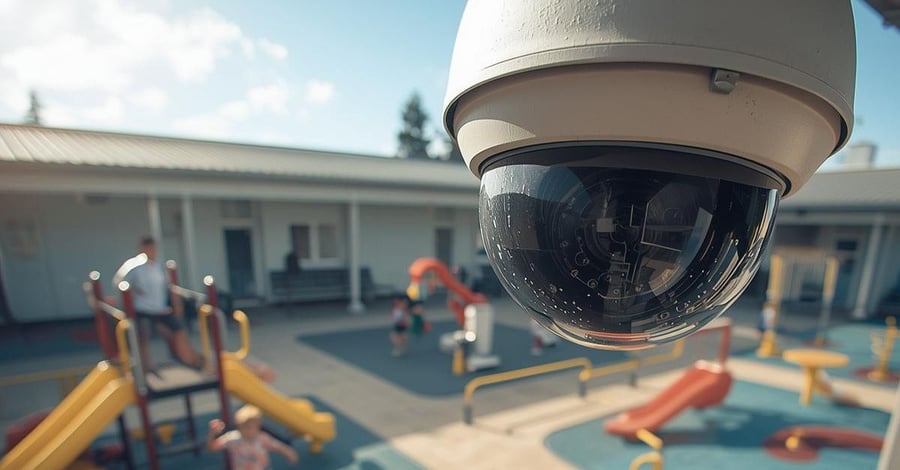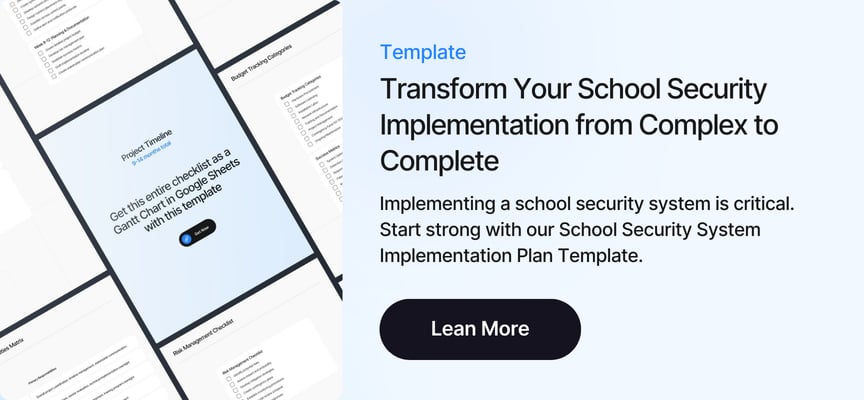Key Points
- Existing camera infrastructure compatibility: Most schools deploy AI-powered security without replacing current security cameras school systems already have, saving capital costs while gaining advanced detection capabilities.
- Flexible deployment models: Choose between serverless cloud deployment for under 100 cameras or on-premises edge deployment for larger installations.
- Network readiness assessment: Current network architecture, bandwidth availability, and firewall configuration determine optimal deployment paths.
- Rapid implementation timeline: Schools achieve full operational status within 5-7 days for edge deployment or 24 hours for cloud systems.
- Integration without disruption: VOLT AI connects to existing video management systems through standard protocols, maintaining operational continuity during implementation.
Your Security Cameras School Systems Are Already Capable
School administrators evaluating AI-powered security solutions face a common question: do we need to replace our existing camera infrastructure? For most institutions, the answer is no.
Your current security cameras school systems already have the technical foundation needed for AI video intelligence. Modern AI security platforms analyze standard video streams using sophisticated algorithms rather than requiring specialized hardware at the camera level. Your investment in existing school security cameras remains protected while gaining detection capabilities that were impossible just years ago.
Understanding why intelligence beats coverage alone when evaluating security camera benefits helps administrators see how software transforms existing hardware into proactive threat detection systems without requiring wholesale replacement.
Camera Compatibility Requirements for School Security Systems
The technical specifications of your existing security cameras school installations use determine compatibility with AI-powered security systems. Understanding these requirements helps administrators make informed decisions about upgrading to intelligent monitoring without unnecessary hardware replacement.
Requirement | Minimum Specification | Optimal Specification | Notes |
Camera Type | IP camera | IP camera | Analog requires encoder |
Protocol Support | RTSP or ONVIF | RTSP and ONVIF | Standard in all modern IP cameras |
Resolution | 720p (1280x720) | 1080p (1920x1080) | Higher resolution improves accuracy |
Frame Rate | 10 fps | 15-30 fps | Higher fps increases bandwidth |
Network Connection | 100 Mbps | Gigabit Ethernet | Affects local network capacity |
Manufacturers | Any standard IP camera | Axis, Hanwha, Hikvision, Dahua | VOLT works with all major brands |
VOLT AI works with any IP camera supporting standard streaming protocols including RTSP (Real-Time Streaming Protocol) or ONVIF (Open Network Video Interface Forum). These protocols are industry-standard features in virtually all IP cameras manufactured in the past decade, making school security camera upgrades straightforward.
Schools with older analog camera systems can use video encoders to convert signals to IP streams, extending the useful life of analog infrastructure while enabling AI capabilities for comprehensive campus security.
Network Architecture Assessment for School Camera Systems
Your network infrastructure serves as the foundation for AI security deployment. Understanding current capabilities guides successful implementation of intelligent school surveillance systems.
Network bandwidth needs vary significantly based on deployment model. Cloud deployment transmits video streams to AWS for processing, requiring sufficient upstream bandwidth for multiple security cameras school districts operate. Edge deployment processes video locally, minimizing external bandwidth while increasing local network traffic.
Camera Count | Cloud Bandwidth (Upstream) | Edge Bandwidth (External) | Notes |
25 cameras | 50-100 Mbps | <10 Mbps | Cloud: 2-4 Mbps per camera |
50 cameras | 100-200 Mbps | <10 Mbps | Edge: Only alerts to cloud |
100 cameras | 200-400 Mbps | <10 Mbps | Edge recommended for 100+ |
200+ cameras | Not recommended | <20 Mbps | Edge deployment required |
Your internal network infrastructure carries video traffic from cameras to processing equipment. Gigabit Ethernet switches handle traffic comfortably for most deployments of school security cameras. Network segmentation through dedicated VLANs isolates camera traffic from other network activities, enhancing both security and performance.
Firewalls require specific configurations to enable camera connectivity while maintaining security. Cloud deployments need HTTPS outbound connections (port 443) to specific AWS endpoints with TLS 1.3 encryption. Edge deployments connect to cameras internally with limited external connectivity for system updates.
Deployment Model Selection Guide for School Security
Choosing between cloud and edge deployment shapes your implementation timeline, maintenance requirements, and technical architecture for security cameras school facilities need.
The cloud deployment model excels for schools monitoring fewer than 100 cameras with adequate internet bandwidth. Implementation begins with a compact mini-PC requiring only network connection and power. The device streams video to AWS infrastructure where AI processing occurs, with complete deployment typically finishing within 24 hours.
Schools with multiple campuses find particular value in this model through centralized management and unified visibility across all locations without maintaining servers at each site. For institutions serving older students, exploring why modern high schools choose AI software before adding more cameras reveals how software-first approaches maximize existing infrastructure value.
Edge deployment suits larger installations, bandwidth-constrained environments, or institutions preferring local data processing. VOLT ships a 1U or 2U rackmount server running the complete AI detection stack locally. Video streams never leave your facility unless an alert requires cloud-based validation. Full deployment typically completes within 5-7 days.
Technical Specifications Comparison
Specification | Cloud Deployment | Edge Deployment |
Camera Limit | Up to 100 cameras | 100+ cameras supported |
Hardware | Mini-PC (provided) | 1U or 2U server (provided) |
Installation Time | 24 hours | 5-7 days |
Network Bandwidth | 2-4 Mbps per camera upstream | Minimal external bandwidth |
Processing Location | AWS cloud infrastructure | On-premises server |
Maintenance | VOLT handles all updates | IT team with VOLT support |
Multi-site Management | Native support | Requires multiple servers |
Capital Expenditure | Minimal | Server hardware included |
Ideal For | <100 cameras, good bandwidth | 100+ cameras or limited bandwidth |
Read the full guide on security cameras for schools.
Integration with Existing School Security Systems
VOLT AI connects to your existing security infrastructure through standard protocols and APIs, preserving your current operational workflows while adding AI-powered detection capabilities to security cameras school systems already use.
Integration Type | Protocol/Method | Benefit |
Video Management Systems | RTSP/ONVIF camera access | Shares camera streams without interference |
Access Control | API integration | Correlates badge events with video analytics |
Emergency Notifications | REST API webhooks | Automates alerts during critical incidents |
911 Services | RapidSOS integration | Direct law enforcement notification |
The system integrates with VMS platforms like Milestone, Genetec, and Verkada by accessing the same camera streams your VMS uses. Security staff continue using familiar interfaces while gaining AI-generated alerts about potential threats from their school security cameras.
For administrators weighing options, understanding whether to integrate AI with current systems or replace them entirely clarifies the strategic and financial advantages of building upon existing investments rather than starting from scratch.
Pre-Deployment Technical Checklist
Successful deployment begins with thorough preparation. This checklist helps IT directors assess readiness before implementation of AI-powered security cameras school districts plan to deploy.
Network infrastructure assessment:
- Camera connectivity: Document current camera locations and network connectivity across your school security system
- Bandwidth measurement: Measure available internet bandwidth during peak usage periods
- Switch capacity: Verify switch capacity for increased camera traffic volumes
- VLAN planning: Identify VLAN segmentation opportunities for security camera networks
Camera inventory:
- Hardware audit: Compile complete camera list with make, model, and location for all security cameras school facilities operate
- Protocol verification: Verify RTSP or ONVIF protocol support across existing cameras
- Performance documentation: Document current resolution and frame rate settings
Security and compliance:
- Firewall configuration: Review firewall rules and required modifications for AI integration
- Retention policies: Document data retention requirements for school surveillance footage
- Regulatory compliance: Verify compliance with state and local regulations governing security cameras school systems must follow
Facility documentation:
- Floor plans: Provide complete floor plans in PDF or CAD format
- Security zones: Identify zones requiring different monitoring levels
- Coverage mapping: Document camera field of view coverage areas
For a deeper dive into comprehensive security planning, The Future of School Security ebook provides frameworks for integrating technology with personnel and protocols to create layered protection strategies that address modern threats.
Privacy and Data Management for School Security Cameras
Privacy concerns accompany any video surveillance system. VOLT AI analyzes behavior patterns rather than identifying individuals, detecting anomalous activities like weapons, fighting, or medical emergencies without using facial recognition technology on security cameras school administrators deploy.
This approach aligns with growing privacy expectations and regulatory requirements in educational environments. Many jurisdictions restrict or prohibit facial recognition in schools while permitting behavioral analysis systems that protect student privacy.
Data security measures for school camera systems:
- Encryption: TLS 1.3 encryption for video streams in transit, AES-256 encryption for stored video
- Access controls: Only authorized personnel can view footage with detailed audit logs
- Compliance: SOC 2 Type 2 certification validates security controls
- Retention: Configurable periods from 30 days to 10 years based on requirements
Schools seeking to understand how AI-powered technology specifically addresses active shooter scenarios can explore detection methodologies that identify weapons before incidents escalate while maintaining student privacy protections.
Cost Considerations and ROI
Traditional security upgrades often require wholesale camera replacement with specialized hardware costing several thousand dollars per unit. A school with 100 cameras might face $500,000 or more in hardware costs alone for new security cameras school budgets cannot accommodate.
VOLT AI eliminates this capital requirement by working with existing cameras. Your previous camera investments continue delivering value while gaining AI capabilities that rival or exceed specialized hardware. AI-powered detection also reduces personnel requirements by enabling small security teams to effectively monitor large campuses through automated alert systems.
When evaluating investment decisions, measuring what actually matters for school security camera ROI helps administrators quantify threat detection speed, false alarm reduction, and investigation efficiency improvements rather than focusing solely on upfront hardware costs.
Why Software-First Security Makes Technical Sense
Traditional security hardware embeds detection logic directly into cameras or specialized equipment, locking you into specific vendors and limiting upgrades to hardware replacement cycles. Software-based AI platforms continuously improve through model updates that immediately benefit all customers without hardware changes to existing security cameras school systems use.
Key software advantages for school security:
- Continuous improvement: Detection models improve through regular updates without hardware replacement
- Customization: Detection sensitivity and alert routing adapt to your environment
- Integration: Software APIs enable integration with emerging technologies
- Future-proof: New features deploy automatically throughout your subscription
Understanding why software ages better than hardware in school security systems reveals how cloud-based AI platforms deliver continuous capability improvements that hardware-based systems cannot match, protecting long-term investments while adapting to evolving threats.
Frequently Asked Questions About AI-Powered School Security Cameras
What types of security cameras school systems can integrate with AI?
VOLT AI works with any IP camera supporting RTSP or ONVIF protocols. This includes virtually all modern security cameras school districts have installed in the past decade, regardless of manufacturer.
How long does it take to deploy AI capabilities on existing security cameras school facilities already have?
Cloud deployment typically completes within 24 hours for systems with fewer than 100 cameras. Edge deployment for larger school camera systems takes 5-7 days from start to full operational status.
Do we need to replace our current security cameras school administrators selected?
No. VOLT AI leverages your existing IP camera infrastructure, protecting your previous investments while adding advanced AI detection capabilities through software integration.
What threats can AI-powered security cameras school systems detect?
VOLT AI detects weapons, fights, medical emergencies, crowd gathering, loitering, and unauthorized access. The system provides comprehensive protection beyond basic motion detection that traditional school security cameras offer.
How does AI improve upon traditional security cameras school districts currently use?
AI provides continuous, intelligent monitoring of 100% of camera feeds 24/7, compared to the 1-2% of feeds human operators can actively monitor. The system never fatigues and responds within seconds of detecting threats.
For K-12 administrators seeking practical implementation guidance, The Complete Guide to AI-Powered School Security Systems webinar walks through deployment scenarios, integration strategies, and real-world performance metrics from schools already using intelligent video analytics.
Partnering with VOLT for Enhanced Campus Safety
Deploying AI-powered security represents a significant step forward in protecting your school community. The ability to leverage existing camera infrastructure makes this transformation accessible without prohibitive capital investment that new security cameras school budgets often cannot support.
VOLT AI transforms your current security cameras school systems have into intelligent monitoring platforms that detect threats in real-time. Whether you choose serverless cloud deployment or on-premises edge processing, proven AI detection capabilities run on your existing hardware investments.
For higher education institutions with unique multi-building campus requirements, The Future of Campus Security guide addresses scalability challenges, integration with access control systems, and coordination with campus police departments to create comprehensive protection strategies.
Security personnel implementing new technology benefit from understanding how AI-powered systems complement school resource officer responsibilities rather than replacing human judgment, creating partnerships between technology and trained professionals that maximize both response effectiveness and community trust.
Ready to transform your existing cameras into proactive safety tools? Contact VOLT to schedule a technical assessment of your infrastructure and explore which deployment model best serves your institution's unique requirements. Our team specializes in seamless integration with existing security cameras school administrators trust, ensuring your investment continues protecting students while gaining advanced AI capabilities that modern threats demand.








